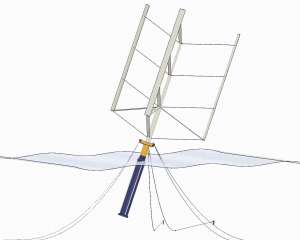Offshore floating vertical axis wind turbine
April 7, 2022
Short summary:
We are developing a vertical axis wind turbine specially designed for offshore floating configuration. Because the turbine is allowed to incline, it can comprise a smaller floating cylindrical structure relative to the mass of the superstructure, whereby the manufacturing and installation costs can be reduced.
Description:
The current mainstream of floating wind turbines is a combination of a horizontal axis wind turbine (HAWT), which has been used widely on land, and a floating structure. HAWTs feature a structure with a high center of gravity, in that the generator is housed in a nacelle located on the upper part of the tower. To keep the structure upright in the waves and wind, a large floating body is required. In general, the cost of the floating body, including mooring and offshore installation work, is higher than that of the wind turbine. Therefore, to reduce power generation costs, it is indispensable to reduce the cost of the floating system. Furthermore, because a floating HAWT needs maintenance work in the nacelle located in the upper part of the tower, which can roll heavily, maintenance costs get higher. Moreover, floating HAWTs are normally installed in areas of the sea that are too deep to use a self-elevating platform (SEP) vessel, meaning a large crane vessel is required to install the tower and wind turbine head. Charter fees for large crane vessels are high and therefore affect the power generation costs.
Another option for wind turbines is the vertical axis wind turbine (VAWT). For VAWTs, the power generating mechanism can be installed in a lower position, meaning the center of gravity of the structure can be lowered. Another advantage of VAWTs is that power can be generated regardless of the wind direction, and even if the wind turbine rotor is tilted, the power generating performance is unlikely to drop, and if fact, it is improved if the wind turbine rotor is tilted within a certain extent. Therefore, it is not necessary to maintain the wind turbine close to the upright position. Our floating axis wind turbine (FAWT) which takes advantage of these characteristics is a floating version of a VAWT. The FAWT is comprised of a VAWT affixed to a substructure—a cylindrical floating body—so that the wind turbine can rotate together with the cylindrical floating body. The FAWT features a low center of gravity and allows the wind turbine to incline, which means that the cylindrical floating body can be made smaller in relation to the mass of the wind turbine located above, leading to a reduction in costs for the floating body system. Moreover, for FAWTs, seawater plays the role of rotation support bearings for the turbine, whereby it dispenses with large bearings. Loss of energy due to viscous friction on the surface of the floating cylindrical body during its rotation decreases the larger the size of the FAWT. Power is taken out by independently suspended generators (*Patent 1) installed on a pontoon. The cylindrical floating body moors the pontoon, keeps the wind turbine in position, and absorbs the reaction torque resulting from power generation.
FAWTs contribute to a reduction in assembly and installation costs (*Patent 2), which in turn reduces power generation costs. The wind turbine and floating body are assembled while laid down on flat ground, with the rotor blades collapsed like an umbrella. The assembly is launched into the sea unchanged in this position and towed to a place where the depth is sufficient to erect the assembly. To obtain the required stability, the center of gravity is lowered by adding ballast—seawater and/or other ballasting material—into the floating body. The rotor blades are then spread in a controlled manner using a winch wire, and blade support arms are secured in place. After spread, the assembly (wind turbine and floating body) is towed to the installation site and connected to the generator pontoon already moored at the installation site. Since this installation work does not require the handling or lifting of heavy objects, charter fees for crane vessels can be saved, and the number of working days, and waiting days due to rough weather as well, can be reduced.
Benefits:
Mining and metals, Greenhouse gases, Electricity
Benefits Description:
– The small floating body uses a smaller amount of steel.
– The material and installation costs are expected to be 50% smaller than conventional turbines with the same output; turbines with twofold the power generating capacity can be installed with the same investment expenditures.
– Our wind turbines are made of recyclable carbon fiber reinforced thermoplastic, alleviating the growing concern regarding the issue of mass disposal of disused large wind turbine blades.
Technology type:
Facility
Developed in:
Japan
Technology appraisal:
Mr. Hiromichi Akimoto, Albatross Technology Co., Ltd., a joint research partner, was awarded Tech Rocketship Award 2019/2020 of the Clean Growth-Approaching Decarbonization category.(https://www.events.great.gov.uk/ehome/ukinjapan/tech-rocketship-awards-2019-20/winners-en)
DEVELOPMENT STATUS:
Readiness level (TRL)
Proof of concept (TRL 3-4)
Collaboration partners
Research collaboration (Kanazawa Institute of Technology, Albatross Technology Co., Ltd.,)
CONDITIONS FOR USE:
Collaboration type
R&D contract or research collaboration, License
Available technical assistance
Documentation
INTELLECTUAL PROPERTY:
| Type | Office | Number | Info |
|---|---|---|---|
| Publication | WIPO PCT | 2020/230685 | Patent |
| Publication | WIPO PCT | 2020/230686 | Patent |
State of Development / Opportunity / Seeking:
・Available for exclusive and non-exclusive licensing
・Exclusive/non-exclusive evaluation for defined period (set up for options)
・Collaborative/supportive research
※Seeking
1. Development partner
2. Licensing
Albatross Technology LLC Website:
http://www.albatross-technology.com/home
WIPO GREEN Database Website:
https://wipogreen.wipo.int/wipogreen-database/database
Figures:
Contact:
![]()
